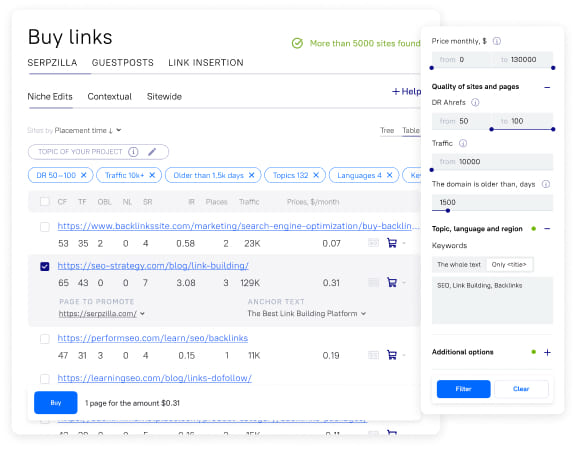SEO as a field of knowledge may have started out with knowing a few important facts about keywords and search engines, but by now it is a complex field of study that has a serious learning curve and requires quite a bit of effort to master. An important aspect of acquiring a good command of SEO is learning your way about its metrics: what measures your success, how to gather necessary data, analyze it and how to use the output in your SEO improvement. Today we will talk in detail about two of the most important metrics in SEO: Trust Flow or TF as it is often abbreviated, and Citation Flow or CF, respectively.
Trust Flow and Citation Flow: Meaning and Brief History
Trust Flow and Citation Flow are proprietary metrics that were introduced by Majestic.com, a company that provides various SEO tools and services.
Citation Flow
Measures the quantity of links to a URL, indicating how influential the URL might be based on the quantity of websites linking to it.
Trust Flow
On the other hand, Trust Flow measures the quality and authority of the sites linking to a URL, summarizing how trustworthy and influential the URL might be based on the quality of the linking sites.
Brief History
They first emerged in 2012 as a response to the market demand for metrics that could measure link building efforts success and a backlink profile performance. While correlation between the quantity and quality of backlinks and SERP results of a site is much more complex than a direct proportion, backlinks still play an important role. Understanding and mathematically analyzing your backlink profile allows you to have a clear picture about its performance and make educated decisions on how to improve it.
In 2017 Majestic released the Flow Metrics History tool which allows to span the changes in TF and CT metrics for a particular URL over the period of a year and a half, reflecting how it changes over time. Today both metrics are still very important and continue to be used by SEO marketers, particularly for competitor analysis, penalty remediation and toxic links analysis and removal.

Why the Balance between TF and CF is important
It would be a huge mistake to think that Trust and Citation Flow can be viewed separately. While they can be measured quite independently, it’s the combination and balance between them that is the most important thing for your SEO.
A site with a high Citation Flow but low Trust Flow may have multiple backlinks, but they might be from low-quality or spammy sources, which can negatively impact its credibility, which in turn can have zero or even negative effect on your backlink profile performance. Vice versa, Low Citation Flow and High Trust Flow can mean that a website was mentioned a couple of times by someone popular and while it’s a good thing on its own, it gives the backlink very little power. As you can see, it’s the combination between the two metrics that makes the link valuable.
Improving Trust and Citation Flow: Key Factors
Both TF and CF are far from rigid metrics and positively respond to efforts directed at their improvement. Here are a few activities that can help you raise both metrics in a balanced combination, if you engage in them regularly:
Create High Quality Content
Creating high quality content does indeed work like a remedy for many SEO problems and improving CF and TF is one of them. Content that is useful, engaging and eagerly shared tends to garner organic high-quality backlinks easily and more naturally, which is your goal.
Monitor your Backlink Profile
Keeping close tabs on your backlinks is essential. Most backlink profiles tend to be rather fluid with situation changing daily, so you should actively monitor all new incoming links and the performance of existing ones and check them regularly for CF/TF combination changes. It’s your safest bet to spot toxic links in a timely manner and act accordingly.
Do not Build Links at Random
Unsystematic link building can be detrimental to all of your SEO efforts. Your link building strategy should be clear and detailed, with transparent goals of various levels and a solid understanding of steps you need to take to reach each goal. This will make your results predictable, manageable and easy to adapt. Understand what value you are aiming it for each metric, not just Trust and Citation Flow, measure your goals against your resources for realism and break the journey into small doable steps before you start.
Analyzing and Monitoring your TF and CF metrics
The perfect combination of Trust Flow and Citation Flow for an average website involves having a balanced ratio between the two metrics. While there is no one-size-fits-all answer, a 1:1 ratio between Citation Flow and Trust Flow is often considered optimal, with an average Trust to Citation Flow ratio of 0.50 being viewed as healthy. A higher ratio indicates an authoritative website, while a lower ratio may suggest low-quality links.
However, you shouldn’t strive to get backlinks only with perfect ratio and high scores in both, as it is hard to achieve in practice and will make your link profile look unnatural. Diversity, again, is key here. It is perfectly fine if your backlinks come from credible, but not very well cited sources, as well as from highly authoritative ones. Rather, you should avoid situations where imbalance is too obvious and metrics are way too askew.
Boost your SEO results! Link building has become fast and easy with Serpzilla. Buy quality backlinks on authority websites with high DR.

Below is a few important tools that will help you monitor your backlinks TF and CF:
Majestic
The obvious choice is the creator of the metrics themselves. They offer a full-features suite for Trust and Citation Flow analysis which can be used for your own website as well as to analyze competitors’ performance. Majestic also has a unique Flow History Tool that allows users to see the dynamic of changes of both metrics for a set period of time, which can be very useful if you want to attribute changes to certain actions in your SEO strategy. Their pricing starts at $50 per month.

WebsiteSEOChecker
While not specifically tailored for TF and CF analysis, it does offer it as a feature among its wide selection of SEO data analysis and monitoring features. While it only offers basic TF and CF metrics analysis, the tool is free and the free version allows users to check Majestic SEO TF and CF, check bulk trust flow and citation flow, and check website trust.
OnCrawl
OnCrawl is another comprehensive SEO analysis tool that offers CF and TF related features as a part of its bundle. This web-based platform provides in-depth analysis and monitoring of these metrics, allowing users to assess the health of their website’s backlink profile and make informed decisions to improve its SEO performance. A plan with 100K URLs per month starts at $39.

Mistakes to Avoid When Working with Trust Flow and Citation Flow Metrics
CF and TF metrics require thoughtful handling if you want them to work for you, not against you. We all know, link building mistakes could ruin every SEO effort. Here are some common pitfalls to avoid when working with CF and TF:
- Focusing only on Citation Flow
Some websites may prioritize the quantity of backlinks without considering the quality of the linking sites. This approach can lead to a high Citation Flow but a low Trust Flow, which may negatively impact the website’s credibility and make your backlink profile stand out in Google’s eyes as unnatural. It is essential to focus on both Citation Flow and Trust Flow to maintain a balanced SEO strategy.
- Ignoring the impact of low-quality links
Citation Flow measures the quantity of links, but it does not take into account the quality of the backlinks. Websites with a diverse range of trustworthy backlinks tend to have higher Trust Flow scores. Ignoring the impact of low-quality links, such as those from spammy websites, low quality Q/A websites or irrelevant forum posts can lead to a poor Trust Flow score and negatively affect the website’s reputation.
- Overemphasizing Trust Flow
While Trust Flow is an essential metric, shifting your focus to it while neglecting the Citation Flow would be misleading. A high Trust Flow score does not necessarily guarantee a high Citation Flow, which measures the quantity of links.You need to monitor both metrics to gain a comprehensive understanding of a website’s authority and link profile. Do not forget, a successful combination is always a tie between TF and CF.
- Irregular Monitoring
TF and Cf are both quite fluid as far as metrics go, so changes can come about quickly and effects will not be long behind. If you don’t want to miss out on important changes and nip any toxic links at the but, your monitoring needs to be constant and your reaction swift. Gathering data for a prolonged period of time will also give you invaluable insights into TF and CF changes and factors that cause them, enabling you to make more precise predictions and calculate your SEO strategy in a much more effective way.
- Disregarding Nofollow links
Nofollow may not directly count against your Citation Flow results, but not marking paid links when it’s blatantly obvious that they’re paid would do you more harm than good. Besides, having a healthy combo of dofollows and nofollows works better to diversify your backlink profile and make it look more natural than trying to raise CF or TF with sneaky schemes.
Key Takeaways
Both Trust Flow and Citation Flow are important SEO metrics that any SEO marketer needs to be familiar with. They require profound understanding, constant monitoring and a specific approach. This approach implies that these metrics are interdependent and should always be viewed in a tie, and that for good performance you need to strive at a good balance between them and build your backlink profile with diversity in mind.








